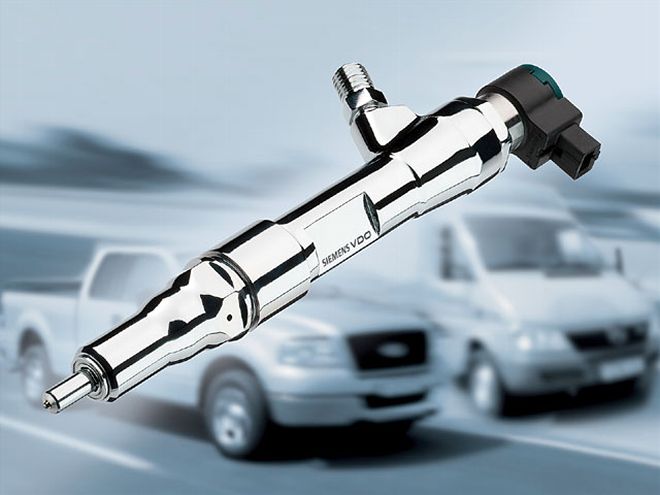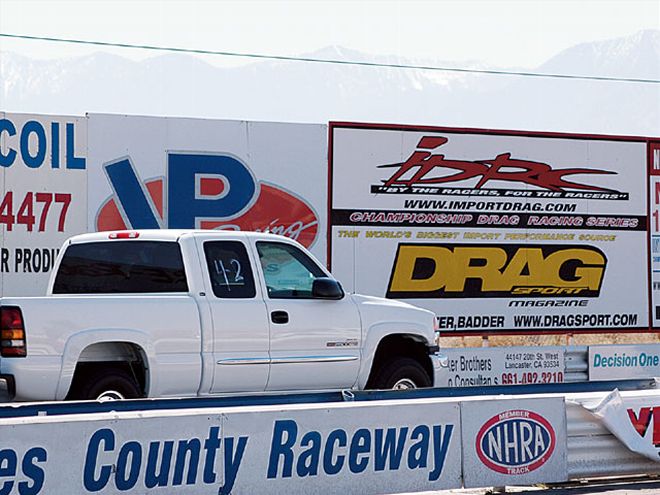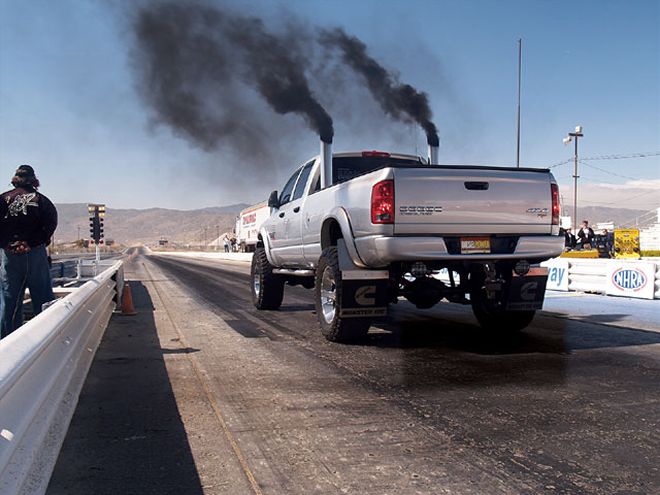
| dodge Ram rear View
As recently as a few years ago, people would've been shocked to hear about diesels on the dragstrip-they're too big, too heavy, and don't have enough power. Now, with the Big Three all offering diesel trucks making over 300 hp and 600 lb-ft of torque, diesel drag racing is on the rise. If you want in, we're going to show you how.
When you first get to the drags, there might be a different entrance for race cars, so make sure you enter that one. After paying an entry fee of usually $20-$50, you'll find a line of cars waiting to be inspected for safety-also known as tech inspection. You'll have to fill out a tech card with the make and model of your diesel as well as other questions like your name, whether you will be running nitrous, and so on. If the tech line is long, drivers can usually start filling the card out before the tech inspector gets to the vehicle.
Most diesels running at the drags are newer models and should have no problem passing the tech inspection. After receiving a thumbs-up from the safety guys, it's on to the staging lanes where drivers wait for their turn to race. There are usually five or six lanes, so make sure you go to the correct ones-some are only for cars running drag slicks.
Lane assignments are usually announced, but ask someone if you're unsure. Whether it's a track official or fellow racer, they'll most likely be helpful-and may even be curious as to why you're bringing a big ol' truck to the drag races. Once you're near the starting line, track officials will signal you forward or use a closed fist, telling you to stop.
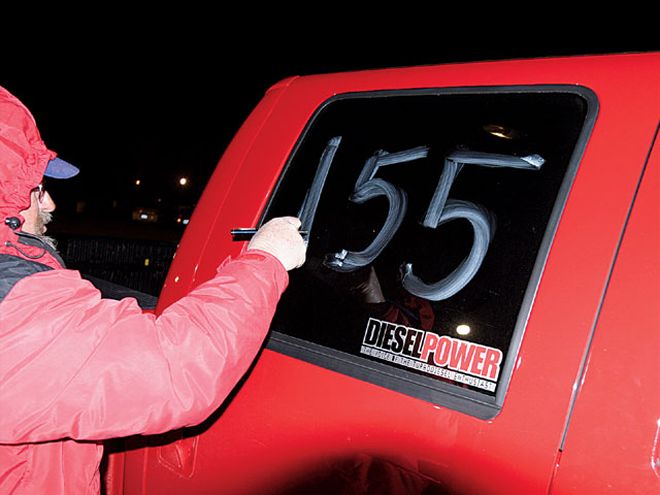
| Our Super Duty was given the number 155. You might also see things like an "X" for nitrous, "deep" (meaning deep staging), "no time" for racers who don't like anyone knowing what they ran, and times like "12.0" or "10.90" for bracket racing, where the goal is to run as close to the time on your window without going under.
There will be an area, known as the water box, where the track is sprayed down with water right in front of you. This is where cars pull in and do burnouts to heat up the tires for better traction. Burnouts do little in the way of traction for normal radial tires, so if your truck is 4WD (unless you have on slicks), you're probably better off skipping the burnout unless you want to show off. Either way, drive around the water. Driving through with radial tires will track water up to the starting line, making it problematic for other racers. If you're going to do a burnout, back into the water and then roll out a few feet. Usually, the starter will motion you how to do this.
The next step is staging the truck. There are two beams of light, 12 inches apart, that constitute the starting line. When you roll into the first one of these beams, the top prestage light will come on. Rolling just a few more inches will turn on both lights, and you will be fully staged. It's better to roll in slowly if you have never done this before; either that, or wait until the other person is staged and use his or her vehicle as a vantage point. Don't worry if you mess up by rolling too far or going too slow on your first attempt. It takes a couple of tries to get used to staging.
If you haven't been spooling up your turbo(s) at this point, you should start now so you'll be at boost when you launch. You can start spooling up earlier, but it's hard on transmissions, so make sure you just give enough throttle for the turbo(s) to start spinning-not necessarily full throttle. For 4WD vehicles, you can usually leave with as much boost as you can make at the line. Two-wheel-drive vehicles should try part-throttle and partial-boost launches to see what will get the best results without spinning the tires.
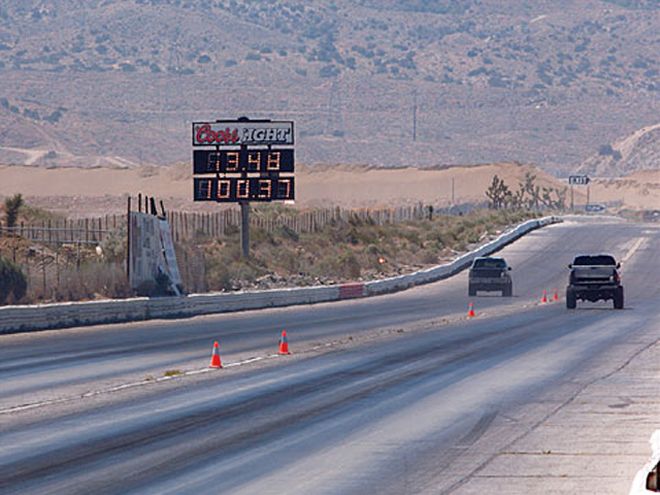
| Note the cones all the way down the track. These will mark your 330-foot, 660-foot, and quarter-mile distances and give times at each point.
Another dragstrip benefit is that it's a good way to benchmark any performance modifications you might have done. Chassis dynos are also a good way to measure power, but dragstrips are a much more real-world driving situation to evaluate performance. Point A to Point B is as basic a method to measure performance as you can get, and it's hard to fool the clock and make things look better or worse than they really are. Just by its nature, a dragstrip will keep drivers honest.
The aftermarket has exploded with performance products, making diesels at the drags a reality. While diesels remain heavy, their enormous power potential combined with 4WD have made diesels seek out the dragstrip to find a place where their owners can experience full-throttle launches and diesel torque without worrying about the law.
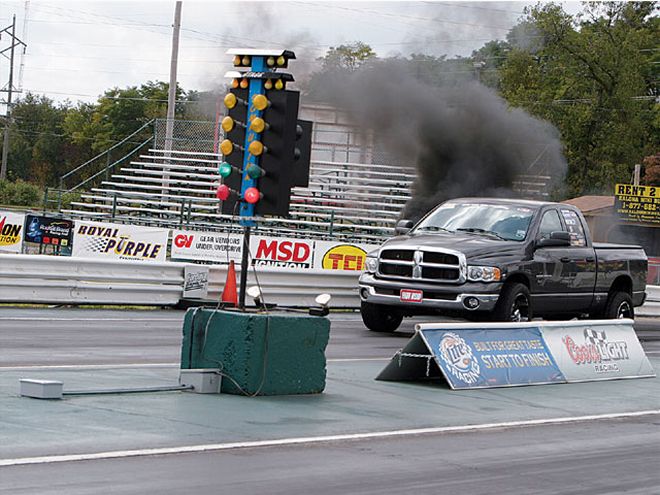
| This is a good example of a launch sequence. You can see where the truck is prestaged, staged, the turbo is spooled up, and then launched. This was at an event where reaction time didn't matter. Otherwise, the truck would've been spooling up while staging.
Don't wait for the green light at the bottom; leave on the last yellow because your vehicle will have to break the last staging beam 12 inches away before your time is started. So, in effect, your vehicle will get a 1-foot head start at the quarter-mile, and you'll be timed over 1,319 feet. Once you're confident with your launches, you can start staging farther in and leaving on the last yellow to try and better your reaction time (a time of 0.00 is perfect). For hard-core racers, a 0.01-0.09-second reaction time is good; track regulars will usually be at 0.1-0.2, and anything above 0.5 is considered "sleeping at the lights."
With diesels, solid dragstrip results can be achieved by just leaving the vehicle in Drive and letting the transmission do the work. If you have a manual transmission, you'd better learn how to shift. We've seen drivers be up to two-tenths quicker (about two car lengths) in the same car just by shifting faster. Also, with 2WD, you'd better learn throttle control. Otherwise, your tires will go up in smoke and your times will be horrible. If you want to be on easy street at the drags, use a 4WD automatic. With that type of truck, the launch is still the most important, but after that, it's just stab and steer.
When you're making a run, try not to pay attention to the next lane; it won't make you go any faster down the track. If your diesel is all hot-rodded up, you may be reaching speeds greater than 100 mph, so make sure your brakes are in decent shape. There will be cones marking your progress, with the finish line coming usually right after the last cone. Get on the brakes as soon as you can, but don't slam them on. There will be plenty of space to stop. Make sure you're not cutting anyone off in the process of slowing down. There will be a turnout on either the left or right side of the dragstrip (check beforehand) where you will exit. There is also a second-chance turnout farther down in case you miss the first one. Somewhere along the return road, there will be a timeslip booth where you can check out your time. Happy racing.
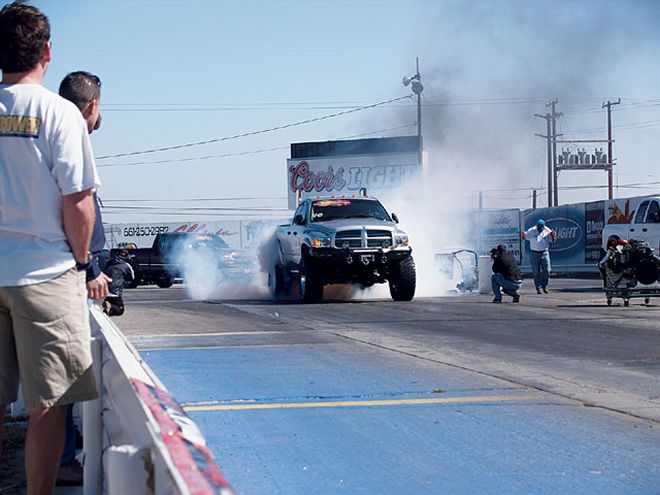
| This is the timeslip from our '08 Ford's race against the '03 H.O. 5.9L Dodge. The points of interest are "reaction" (reaction time), "I1" (60-foot time), "I3" (eighth-mile time), "e.t." (quarter-mile time), and "mph." As you can see, the Dodge driver got us with a better reaction time, but we pulled out in front with a much better 60-foot time (2.14 seconds versus 2.42 seconds) and kept leading at the eighth-mile and quarter-mile marks. The "m.o.v.," or margin of victory was 0.928.
Here is a short guide to what you should and shouldn't do at the strip. These guidelines may vary from track to track, so if you have any questions, don't be afraid to ask a track official.
* Have an overflow tank for your radiator that works and doesn't leak.
* In fact, don't leak anything. Leaking oil, fuel, water, or anything else will get you sidelined until it's repaired.
* If you plan on running faster than 13.99 seconds on the quarter-mile, bring a helmet. If you're running 13.99 seconds or slower, you're allowed to have passengers.
* Don't do a monster burnout. If you do, ask a track official if it's OK. Tell him your friend is taking pictures, and he'll probably let you. Doing a burnout past the starting line is also a no-no.
* Make sure your battery is securely held down. If it can bounce around the engine compartment, you won't be going down the track.
* Don't miss the return roads, turn around at the end of the track, and drive back toward the line. This will really aggravate the officials. If you're worried about doing this, make a slow first pass to see where the turns are to exit the track before doing it at speed.
* Practice improving your reaction time. Even if you aren't the fastest on the track, you can still be a great driver.
* Extra weight will slow you down. On our recent drag test with an '08 Ford, we were running two-tenths slower with a passenger.
* Don't cut anyone off to exit the track. The '70s musclecar with drum brakes might not be able to stop as quickly as you.
* Don't speed on the return roads. The dragstrip is the dragstrip.
 | dodge Ram rear View
As recently as a few years ago, people would've been shocked to hear about diesels on the dragstrip-they're too big, too heavy, and don't have enough power. Now, with the Big Three all offering diesel trucks making over 300 hp and 600 lb-ft of torque, diesel drag racing is on the rise. If you want in, we're going to show you how.
When you first get to the drags, there might be a different entrance for race cars, so make sure you enter that one. After paying an entry fee of usually $20-$50, you'll find a line of cars waiting to be inspected for safety-also known as tech inspection. You'll have to fill out a tech card with the make and model of your diesel as well as other questions like your name, whether you will be running nitrous, and so on. If the tech line is long, drivers can usually start filling the card out before the tech inspector gets to the vehicle.
Most diesels running at the drags are newer models and should have no problem passing the tech inspection. After receiving a thumbs-up from the safety guys, it's on to the staging lanes where drivers wait for their turn to race. There are usually five or six lanes, so make sure you go to the correct ones-some are only for cars running drag slicks.
Lane assignments are usually announced, but ask someone if you're unsure. Whether it's a track official or fellow racer, they'll most likely be helpful-and may even be curious as to why you're bringing a big ol' truck to the drag races. Once you're near the starting line, track officials will signal you forward or use a closed fist, telling you to stop.
| dodge Ram rear View
As recently as a few years ago, people would've been shocked to hear about diesels on the dragstrip-they're too big, too heavy, and don't have enough power. Now, with the Big Three all offering diesel trucks making over 300 hp and 600 lb-ft of torque, diesel drag racing is on the rise. If you want in, we're going to show you how.
When you first get to the drags, there might be a different entrance for race cars, so make sure you enter that one. After paying an entry fee of usually $20-$50, you'll find a line of cars waiting to be inspected for safety-also known as tech inspection. You'll have to fill out a tech card with the make and model of your diesel as well as other questions like your name, whether you will be running nitrous, and so on. If the tech line is long, drivers can usually start filling the card out before the tech inspector gets to the vehicle.
Most diesels running at the drags are newer models and should have no problem passing the tech inspection. After receiving a thumbs-up from the safety guys, it's on to the staging lanes where drivers wait for their turn to race. There are usually five or six lanes, so make sure you go to the correct ones-some are only for cars running drag slicks.
Lane assignments are usually announced, but ask someone if you're unsure. Whether it's a track official or fellow racer, they'll most likely be helpful-and may even be curious as to why you're bringing a big ol' truck to the drag races. Once you're near the starting line, track officials will signal you forward or use a closed fist, telling you to stop.
 | Our Super Duty was given the number 155. You might also see things like an "X" for nitrous, "deep" (meaning deep staging), "no time" for racers who don't like anyone knowing what they ran, and times like "12.0" or "10.90" for bracket racing, where the goal is to run as close to the time on your window without going under.
There will be an area, known as the water box, where the track is sprayed down with water right in front of you. This is where cars pull in and do burnouts to heat up the tires for better traction. Burnouts do little in the way of traction for normal radial tires, so if your truck is 4WD (unless you have on slicks), you're probably better off skipping the burnout unless you want to show off. Either way, drive around the water. Driving through with radial tires will track water up to the starting line, making it problematic for other racers. If you're going to do a burnout, back into the water and then roll out a few feet. Usually, the starter will motion you how to do this.
The next step is staging the truck. There are two beams of light, 12 inches apart, that constitute the starting line. When you roll into the first one of these beams, the top prestage light will come on. Rolling just a few more inches will turn on both lights, and you will be fully staged. It's better to roll in slowly if you have never done this before; either that, or wait until the other person is staged and use his or her vehicle as a vantage point. Don't worry if you mess up by rolling too far or going too slow on your first attempt. It takes a couple of tries to get used to staging.
If you haven't been spooling up your turbo(s) at this point, you should start now so you'll be at boost when you launch. You can start spooling up earlier, but it's hard on transmissions, so make sure you just give enough throttle for the turbo(s) to start spinning-not necessarily full throttle. For 4WD vehicles, you can usually leave with as much boost as you can make at the line. Two-wheel-drive vehicles should try part-throttle and partial-boost launches to see what will get the best results without spinning the tires.
| Our Super Duty was given the number 155. You might also see things like an "X" for nitrous, "deep" (meaning deep staging), "no time" for racers who don't like anyone knowing what they ran, and times like "12.0" or "10.90" for bracket racing, where the goal is to run as close to the time on your window without going under.
There will be an area, known as the water box, where the track is sprayed down with water right in front of you. This is where cars pull in and do burnouts to heat up the tires for better traction. Burnouts do little in the way of traction for normal radial tires, so if your truck is 4WD (unless you have on slicks), you're probably better off skipping the burnout unless you want to show off. Either way, drive around the water. Driving through with radial tires will track water up to the starting line, making it problematic for other racers. If you're going to do a burnout, back into the water and then roll out a few feet. Usually, the starter will motion you how to do this.
The next step is staging the truck. There are two beams of light, 12 inches apart, that constitute the starting line. When you roll into the first one of these beams, the top prestage light will come on. Rolling just a few more inches will turn on both lights, and you will be fully staged. It's better to roll in slowly if you have never done this before; either that, or wait until the other person is staged and use his or her vehicle as a vantage point. Don't worry if you mess up by rolling too far or going too slow on your first attempt. It takes a couple of tries to get used to staging.
If you haven't been spooling up your turbo(s) at this point, you should start now so you'll be at boost when you launch. You can start spooling up earlier, but it's hard on transmissions, so make sure you just give enough throttle for the turbo(s) to start spinning-not necessarily full throttle. For 4WD vehicles, you can usually leave with as much boost as you can make at the line. Two-wheel-drive vehicles should try part-throttle and partial-boost launches to see what will get the best results without spinning the tires.
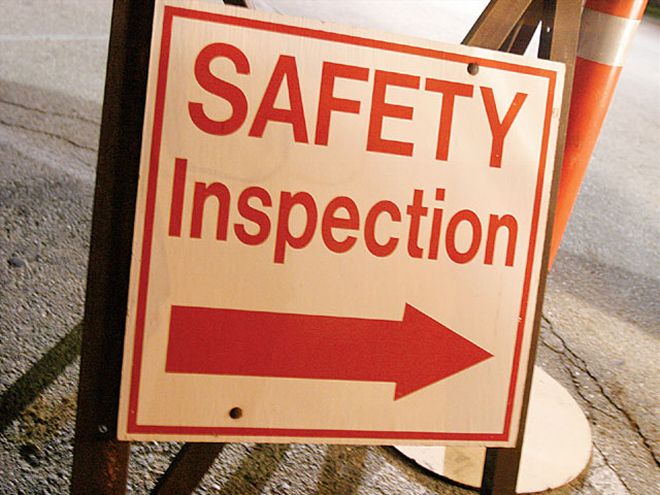
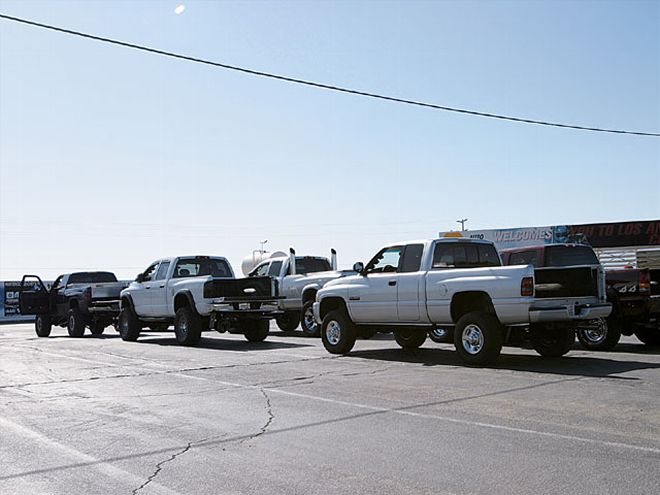
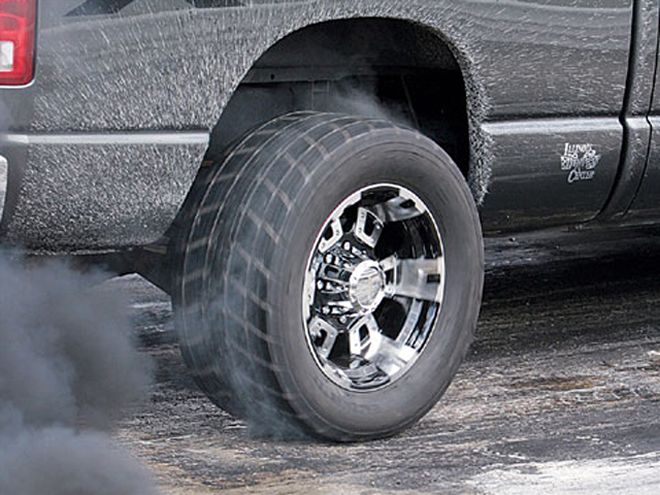
 | Note the cones all the way down the track. These will mark your 330-foot, 660-foot, and quarter-mile distances and give times at each point.
Another dragstrip benefit is that it's a good way to benchmark any performance modifications you might have done. Chassis dynos are also a good way to measure power, but dragstrips are a much more real-world driving situation to evaluate performance. Point A to Point B is as basic a method to measure performance as you can get, and it's hard to fool the clock and make things look better or worse than they really are. Just by its nature, a dragstrip will keep drivers honest.
The aftermarket has exploded with performance products, making diesels at the drags a reality. While diesels remain heavy, their enormous power potential combined with 4WD have made diesels seek out the dragstrip to find a place where their owners can experience full-throttle launches and diesel torque without worrying about the law.
| Note the cones all the way down the track. These will mark your 330-foot, 660-foot, and quarter-mile distances and give times at each point.
Another dragstrip benefit is that it's a good way to benchmark any performance modifications you might have done. Chassis dynos are also a good way to measure power, but dragstrips are a much more real-world driving situation to evaluate performance. Point A to Point B is as basic a method to measure performance as you can get, and it's hard to fool the clock and make things look better or worse than they really are. Just by its nature, a dragstrip will keep drivers honest.
The aftermarket has exploded with performance products, making diesels at the drags a reality. While diesels remain heavy, their enormous power potential combined with 4WD have made diesels seek out the dragstrip to find a place where their owners can experience full-throttle launches and diesel torque without worrying about the law.
 | This is a good example of a launch sequence. You can see where the truck is prestaged, staged, the turbo is spooled up, and then launched. This was at an event where reaction time didn't matter. Otherwise, the truck would've been spooling up while staging.
Don't wait for the green light at the bottom; leave on the last yellow because your vehicle will have to break the last staging beam 12 inches away before your time is started. So, in effect, your vehicle will get a 1-foot head start at the quarter-mile, and you'll be timed over 1,319 feet. Once you're confident with your launches, you can start staging farther in and leaving on the last yellow to try and better your reaction time (a time of 0.00 is perfect). For hard-core racers, a 0.01-0.09-second reaction time is good; track regulars will usually be at 0.1-0.2, and anything above 0.5 is considered "sleeping at the lights."
With diesels, solid dragstrip results can be achieved by just leaving the vehicle in Drive and letting the transmission do the work. If you have a manual transmission, you'd better learn how to shift. We've seen drivers be up to two-tenths quicker (about two car lengths) in the same car just by shifting faster. Also, with 2WD, you'd better learn throttle control. Otherwise, your tires will go up in smoke and your times will be horrible. If you want to be on easy street at the drags, use a 4WD automatic. With that type of truck, the launch is still the most important, but after that, it's just stab and steer.
When you're making a run, try not to pay attention to the next lane; it won't make you go any faster down the track. If your diesel is all hot-rodded up, you may be reaching speeds greater than 100 mph, so make sure your brakes are in decent shape. There will be cones marking your progress, with the finish line coming usually right after the last cone. Get on the brakes as soon as you can, but don't slam them on. There will be plenty of space to stop. Make sure you're not cutting anyone off in the process of slowing down. There will be a turnout on either the left or right side of the dragstrip (check beforehand) where you will exit. There is also a second-chance turnout farther down in case you miss the first one. Somewhere along the return road, there will be a timeslip booth where you can check out your time. Happy racing.
| This is a good example of a launch sequence. You can see where the truck is prestaged, staged, the turbo is spooled up, and then launched. This was at an event where reaction time didn't matter. Otherwise, the truck would've been spooling up while staging.
Don't wait for the green light at the bottom; leave on the last yellow because your vehicle will have to break the last staging beam 12 inches away before your time is started. So, in effect, your vehicle will get a 1-foot head start at the quarter-mile, and you'll be timed over 1,319 feet. Once you're confident with your launches, you can start staging farther in and leaving on the last yellow to try and better your reaction time (a time of 0.00 is perfect). For hard-core racers, a 0.01-0.09-second reaction time is good; track regulars will usually be at 0.1-0.2, and anything above 0.5 is considered "sleeping at the lights."
With diesels, solid dragstrip results can be achieved by just leaving the vehicle in Drive and letting the transmission do the work. If you have a manual transmission, you'd better learn how to shift. We've seen drivers be up to two-tenths quicker (about two car lengths) in the same car just by shifting faster. Also, with 2WD, you'd better learn throttle control. Otherwise, your tires will go up in smoke and your times will be horrible. If you want to be on easy street at the drags, use a 4WD automatic. With that type of truck, the launch is still the most important, but after that, it's just stab and steer.
When you're making a run, try not to pay attention to the next lane; it won't make you go any faster down the track. If your diesel is all hot-rodded up, you may be reaching speeds greater than 100 mph, so make sure your brakes are in decent shape. There will be cones marking your progress, with the finish line coming usually right after the last cone. Get on the brakes as soon as you can, but don't slam them on. There will be plenty of space to stop. Make sure you're not cutting anyone off in the process of slowing down. There will be a turnout on either the left or right side of the dragstrip (check beforehand) where you will exit. There is also a second-chance turnout farther down in case you miss the first one. Somewhere along the return road, there will be a timeslip booth where you can check out your time. Happy racing.
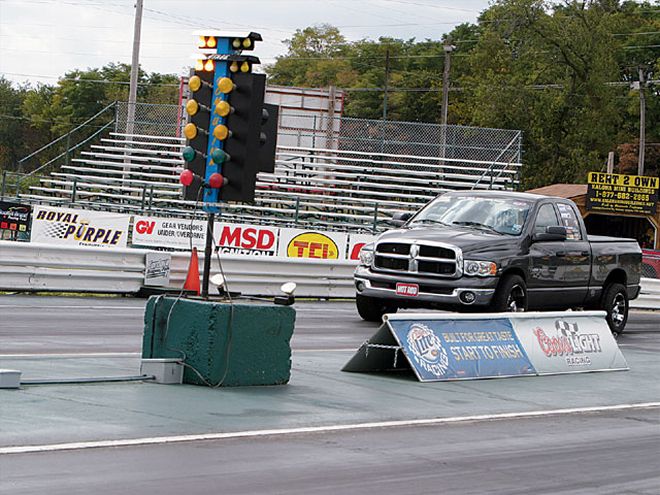


 | This is the timeslip from our '08 Ford's race against the '03 H.O. 5.9L Dodge. The points of interest are "reaction" (reaction time), "I1" (60-foot time), "I3" (eighth-mile time), "e.t." (quarter-mile time), and "mph." As you can see, the Dodge driver got us with a better reaction time, but we pulled out in front with a much better 60-foot time (2.14 seconds versus 2.42 seconds) and kept leading at the eighth-mile and quarter-mile marks. The "m.o.v.," or margin of victory was 0.928.
Here is a short guide to what you should and shouldn't do at the strip. These guidelines may vary from track to track, so if you have any questions, don't be afraid to ask a track official.
* Have an overflow tank for your radiator that works and doesn't leak.
| This is the timeslip from our '08 Ford's race against the '03 H.O. 5.9L Dodge. The points of interest are "reaction" (reaction time), "I1" (60-foot time), "I3" (eighth-mile time), "e.t." (quarter-mile time), and "mph." As you can see, the Dodge driver got us with a better reaction time, but we pulled out in front with a much better 60-foot time (2.14 seconds versus 2.42 seconds) and kept leading at the eighth-mile and quarter-mile marks. The "m.o.v.," or margin of victory was 0.928.
Here is a short guide to what you should and shouldn't do at the strip. These guidelines may vary from track to track, so if you have any questions, don't be afraid to ask a track official.
* Have an overflow tank for your radiator that works and doesn't leak.
